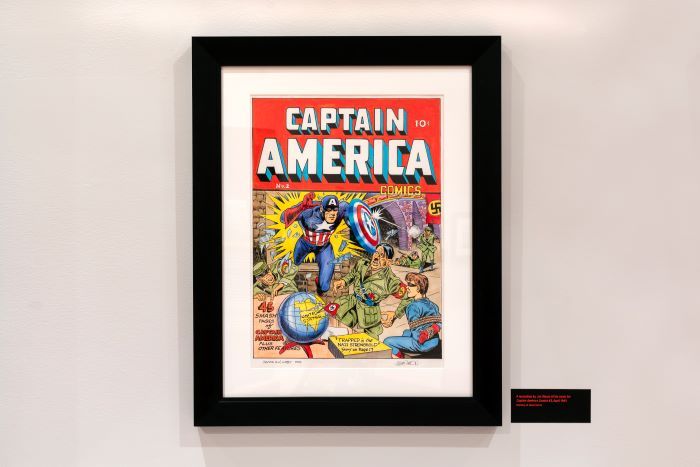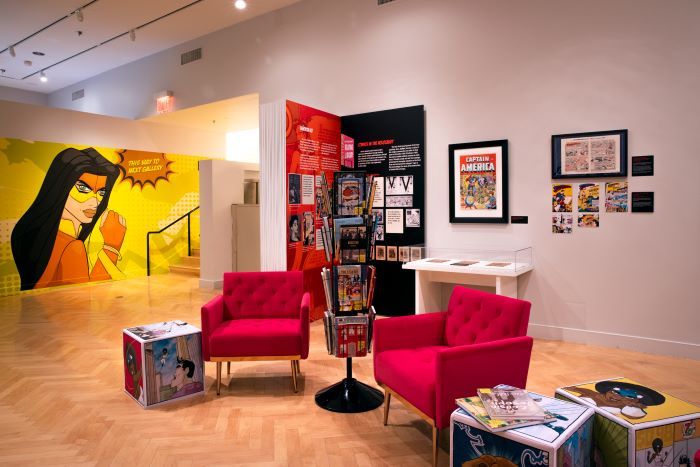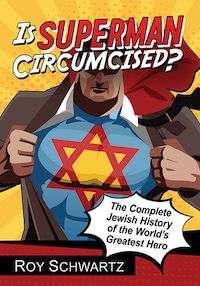Products You May Like
New York City-based Center for Jewish History opened its ambitious exhibition JewCE! The Museum and Laboratory of the Jewish Comics Experience from October 9th until the end of the year. JewCE (pronounced Juice) aims to explore Jewish influence and history in comics, including exploring how comics embody Jewish themes and culture in five micro-exhibits.
The Experience also includes the Laboratory, which allows adults and children to make their own comics and superheroes. There are activities to storyboard comics, whiteboards on all the walls to create your own comics, as well as photo opportunities with props and costumes specially made for the show. There is a reading library where people can read comics. On top of that, the Center will be hosting the JewCe convention from November 11th to 13th to celebrate Jewish comics.
The Importance of JewCE
JewCE has several multi-faceted intentions, explained Miriam Mora, Director of Programs at the Center and JewCE co-creator. The first is to “highlight the Jewishness of the comic industry and the comic medium,” Dr. Mora explained. Second, it explores how Jewish people have been represented on the page. Third, the exhibition talks about how comics are showing a more accurate spectrum of Jewish identities across the globe right now.
“A lot of the exhibit is about identity, and how you define Jewish identity, and how you can’t define Jewish identity. How it’s an undefinable thing, but the ways in which we craft identity onto the page,” Dr. Mora explained. However, she stressed that this is not an exhibition about Jewish people who make comics, but rather “about Jewish comics and the people that make them.”
Co-curator Roy Schwartz, an author of Is Superman Circumcised? The Complete Jewish History of the World’s Greatest Hero and pop culture writer for CNN, explained further that both superheroes and comic books are Jewish inventions. While comic books are the biggest thing in show business, “their historical origins are much more modest in their origin,” Schwartz said. “Comic books were created by a handful of Jewish immigrants in New York in the hardscrabble east side and working-class Bronx in the 1930s and ’40s. Inevitably, they injected their cultural background, religious, cultural, historical, into their work.”
But Schwartz also stressed that this exhibition was not just for Jewish folks or comic book fans. “It’s an exploration of the history and themes of an immensely popular, beloved original American art form. We really want everybody from every background, every age group, every level of interest to come in, have a great time, and learn new things,” he said.
Within the Exhibition
The five micro-exhibits — “like five chapters in a book,” Schwartz says — have different focuses, thanks to the five partner organizations that call the Center its home: American Jewish Historical Society, American Sephardi Federation, Leo Baeck Institute, Yeshiva University Museum, and YIVO Institute for Jewish Research. One micro-exhibit will showcase the Jewish origins of the comic book industry; one explores how comics were used to fight fascism, including Holocaust survivor Renée Lily, known for her depiction of Senorita Rio; another will focus on comics made by Jewish people outside of Europe — to name a few.

Schwartz is particularly excited that Jesse Simon, the grandson of Joe Simon, the co-creator of Captain America, will be bringing original Captain America art by his grandfather that had not been seen publicly before.
Another unique piece in the exhibition will be a proto-Superman comic before his debut in 1938. In 1933, Jerry Siegel, co-curator of Superman, wrote a five-issue self-published fanzine called Reign of Superman, where Superman was the villain. “For the first time anywhere in the world ever, we have every page of those five issues scanned for people to read.”
People can see the mimeographed issues right next to a touchscreen where they can read the issue. “It’s a rare experience to have to read it with the original sitting right there. So I’m very excited about that from a kind of Uber nerd perspective,” Dr. Mora explained.
The Origins of JewCE
The original idea for the exhibition started with the convention. “I wanted to do a Jewish ComiCon at the Center for Jewish History,” Dr. Mora said. She had missed the first two Jewish Comic Cons in Brooklyn in 2016 and 2018. She partnered with Fabrice Sapolsky, one of the creators of the Comic Con and co-creator of Spider-Man Noir, to create the JewCe convention. Dr. Mora noted that the conventions have different goals: “It’s like the difference between looking at the Jewish creators and looking at Jewish content.”

“As far as the goals for the convention, the biggest goals are to highlight and elevate comic creators whether or not they’re Jewish. These are people who are doing some Jewish content, who are in some way adding to the diverse Jewish narrative that are going into the world through this arguably very Jewish medium,” Dr. Mora added.
The convention will feature a variety of comic book creators, including Trina Robbins, as the Will Eisner Hall of Famer guest of honor; Yehudi Mercado, creator of Chunky; E. Lockhart, creator of Whistle; the legend Brian Michael Bendis; and many more. Dr. Mora noted that more guests are going to come to the convention, so they’ll keep updating the convention guests page. On top of panels, artists alley, and other conference staples, they will be debuting JewCE Awards “by honoring the creators of Jewish comic book narratives, themes, and characters,” according to the convention website.
Ultimately, Dr. Mora wanted people to know JewCE is about Jewish joy, not antisemitism. “There is no better antidote to antisemitism than celebrating Jewish joy, good Jewish content, and saying Jewish comics are not all about the Holocaust,” she said.
For more articles on comics and Jewish people, check out my brief history of superheroes. Here’s another article on superheroes and the immigrant experience.

